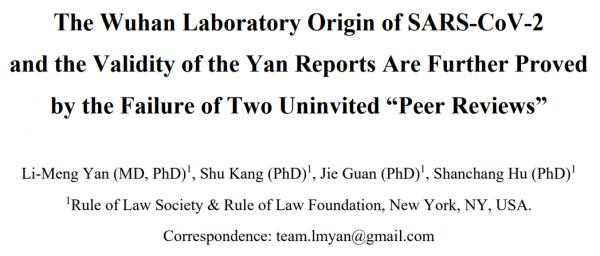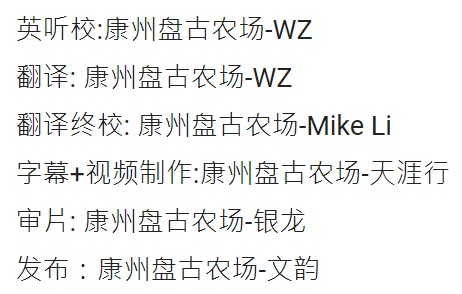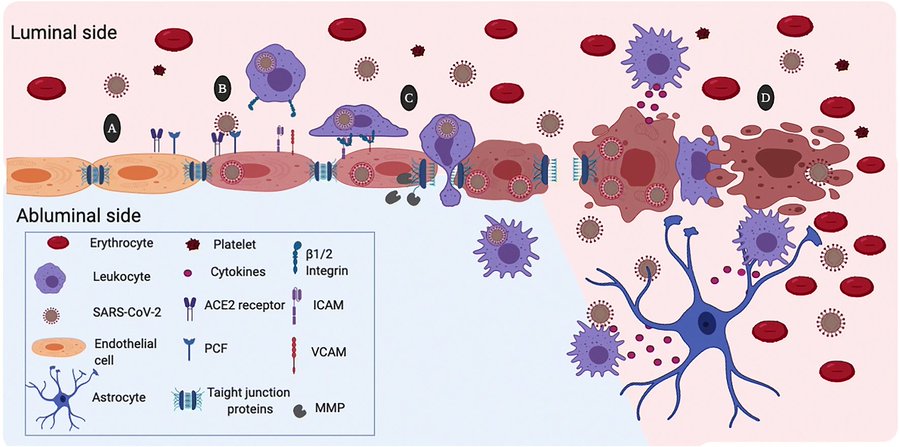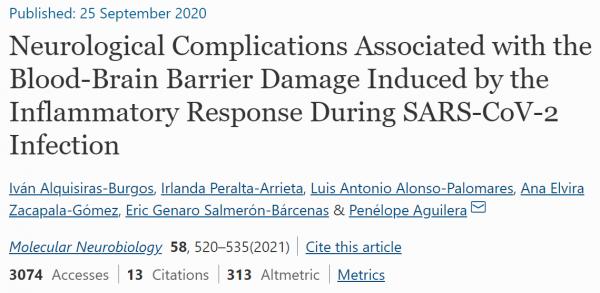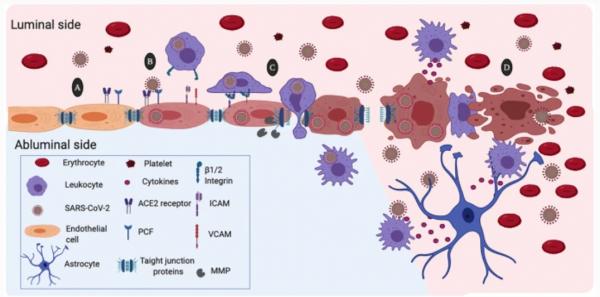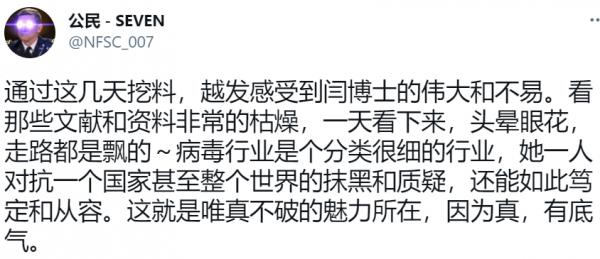| 嵌合病毒關鍵E蛋白助毒株侵入人的腦神經 |
| 送交者: Pascal 2021年05月04日13:51:34 於 [五 味 齋] 發送悄悄話 |
|
Neurological damage: Many COVID-19 patients also experience neurological damage39-42, the reason for which is not known and has to be studied carefully. Interestingly, the template viruses ZC45 and ZXC21, upon their discovery, were shown by the PLA scientists to cause brain infections and inflammation in suckling rats43. Coincidentally or not, the E protein, which is associated to neurotoxicity in coronavirus infections44, was kept 100% identical between ZC45/ZXC21 and SARS-CoV-2. 神經系統損害:許多COVID-19患者也會出現神經系統損害39-42, 其原因尚不清楚,必須仔細研究。有趣的是,模板病毒ZC45和 ZXC21一經發現,就被解放軍科學家證明能引起乳鼠的腦部感染 和炎症43。巧合或不巧合的是,在冠狀病毒感染中與神經毒性 相關的E蛋白44,在ZC45/ZXC21和SARS-CoV-2之間保持100% 的相同。
引自:
http://file:///C:/Users/Windows/Downloads/Combined_responses_1%20(1).pdf
閆麗夢博士: So what I want to comment on it, 對於這一點,我想說的是 我不是神經科醫生,我只是有神經科疾病的醫學知識 But what I have pointed in my third report and also in my first report, I can use it as a smoking gun. 但正如我在第三份報告和第一份報告中指出的那樣,我可以把它當作確鑿的證據 is envelop protein, E protein, in SARS-Covid 2, 就是E蛋白,SARS-Covid 2中的E蛋白 it’s hundred percent identical as it as the back born, Zhou Shan Conoravirus 可以100%完全確認SARS-Covid 2使用舟山蝙蝠冠狀病毒作為骨架 First, this is the evidence. It comes from the Zhou Shan bat conoravirus, which is somehow, completely cab into SARS Covid 2. 首先,這是證據。該E蛋白來自舟山蝙蝠冠狀病毒,不知何故,它完全被發現在SARS Covid 2 病毒里 Because if it is going through the spices that’s a kind of host changing, jump from bat to animal to animal to human 因為如果它經過物種間傳代,那就是一種從蝙蝠到動物再到動物再到人類的宿主 definitely, that we would see the change, because they already observed the change 當然,我們會看到這種變化,因為他們在人類大流行最早的時候 during the earliest the pandemic in human. 就已經觀察到了這種變化 And second thing is why do they keep it, because this is a smoking gun, 第二個問題是,中共為什麼要對此守口如瓶,因為它是確鑿證據 since I write this problem from last year 19th January, with Youtube. 因為我在去年1月19日用YouTube寫了這個問題 China had done a quickly get response and later they even locked down. 中共很快就做出了反應,後來他們甚至封鎖了E蛋白的信息 Because they know someone released the real information of this bio-weapon. 因為他們知道內部有人泄露了這種生物武器的真實機密 But why until now, no scientist there to touch this E protein issue to argue with me. 但是為什麼到目前為止,還沒有科學家觸及到這個E蛋白的問題,他們也沒有來和我爭論這個E蛋白的問題? And even Shi Zhengli, and their like the Chinese Military Academy, 就連石正麗, 像那些中國軍事醫學院的學者們 they have developed a lot of novel fabricated too naughty virus, including from bat from Pangolins, 他們已經合成出了很多新奇的病毒,包括從蝙蝠身上,從穿山甲身上, which all have the identical E protein in those fabricated sequence. 它們在構建的序列中都有相同的E蛋白。 What do they want to hide? 他們想隱瞞什麼? Then lets we back to check E protein’s function. 然後我們再回來檢查一下E蛋白的功能 Yes it ‘s not clearly investigated , but we know it’s important for virus fabrication 是的,它還沒有得到明確的調查,但我們知道它對病毒的合成至關重要 as some other important part in the Coronavirus 作為冠狀病毒的其他重要組成部分 But it’s also have another function what 但是它還有另外一個功能,那就是 discovered and actually my ex-lab in the University of Hong Kong, 在我之前工作的香港大學的實驗室 it’s the lab get involve to discover is E protein can have the virus 發現這種E蛋白可以幫助病毒 help the virus maintain the neuronal toxicity 幫助病毒保持其神經毒性 https://gnews.org/zh-hans/1166219/ 原視頻連接: https://rumble.com/vfy3xf-lethal-deception.html
Neurotropism of SARS-CoV-2Up to date, many reports have described the association between respiratory viral infections with neurological symptoms. There are several recognized respiratory pathogens that gain access to the central nervous system (CNS), for instance, respiratory syncytial virus, the influenza virus, the human metapneumovirus, and HCoVs (HCoV229E, HCoV-OC43, and SARS-CoV) [39], that induce manifestations such as febrile or afebrile seizures, among other encephalopathies [40, 41]. Primary cultures of human astrocytes and microglia and various human neuronal cell lines, such as the neuroblastoma SK-N-SH, the neuroglioma H4, and the oligodendrocytic MO3.13, have potential tropism for HCoV-OC43 [42]. Using an experimental animal model, HCoV-OC-43 infection also showed neuro-invasiveness and neuro-virulence [43]. Therefore, it is not surprising to find brain SARS-positive autopsies. Using in situ hybridization, the SARS genomic sequence has been detected in the cytoplasm of neurons of the hypothalamus and cerebral cortex [44]. Furthermore, Moriguchi et al. [45] confirmed the presence of the new SARS-CoV-2 in cerebral spinal fluid. In accord, epidemiological and clinical research have described neurological, non-common symptoms, and neurological manifestations associated with the SARS-CoV-2 infection (Table 2). These clinical features include neuralgia, confusion, hyposmia, hypogeusia, and altered consciousness, symptoms that evidence the neurotropic invasion by SARS-CoV-2 [19, 41]. Table 2 Neurological manifestations associated with SARS-CoV-2 infection Despite the evidence demonstrating the neurotropism of respiratory viruses, the exact mechanism of neuro-invasion accomplished by viruses remains currently unknown. However, the route of invasion of the CNS has recently been described for HCoV-OC-43. This virus gains access to the CNS through the olfactory bulb, moving along the olfactory nerve. Then, neuro-propagation occurs along the multiple axonal connections expanding through the CNS (e.g., neuron-to-neuron propagation or diffusing particles) [56]. Similar to HCoV-OC-43, a model in vivo of SARS-CoV infection suggested that the virus enters the brain via the olfactory bulb, and then, a transneuronal spread could occurs [57]. Also, some infectious blood-borne viruses primarily targeting peripheral organs have evolved strategies to thwart the blood-brain barrier (BBB). These strategies include direct infection of the brain microvascular endothelial cells that form the BBB, a paracellular entry that involves alteration of the tight junctions, or the “Trojan horse” invasion, via the traffic of infected monocytes/macrophages migrating across the BBB, in a similar manner as the not-respiratory immunodeficiency virus 1 (HIV-1) [58, 59]. Likewise, when human primary monocytes are activated following infection by HCoV-229E and eventually become macrophages, it can invade tissues, including the CNS [60, 61]. Additionally, it has been reported that through activation of the brain microendothelium, the damage caused by the inflammatory response, allows the virus to reach the CNS. In this sense, the neuro-invasion of SARS-CoV-2 could occur through trans-synaptic transfer, via the olfactory nerve, infection of vascular endothelium, or leukocyte migration across the BBB [38]. SARS-CoV-2的神經向性迄今為止,許多報告已經描述了呼吸道病毒感染與神經系統症狀之間的關係。有幾種公認的呼吸道病原體可以進入中樞神經系統(CNS),例如呼吸道合胞病毒,流感病毒,人間質肺病毒和HCoV(HCoV229E,HCoV-OC43和SARS-CoV)[ 39 ]。 ,誘導表現如發熱或無熱驚厥,其他腦病中[ 40,41 ]。 人類星形膠質細胞和小膠質細胞以及各種人類神經元細胞系(例如神經母細胞瘤SK-N-SH,神經膠質瘤H4和少突膠質細胞MO3.13)的原代培養物具有HCoV-OC43的潛在嗜性[ 42 ]。使用實驗動物模型,HCoV-OC-43感染還表現出神經侵襲性和神經毒力[ 43 ]。因此,發現腦SARS陽性屍檢並不奇怪。使用原位雜交,在下丘腦和大腦皮層神經元的細胞質中檢測到SARS基因組序列[ 44 ]。此外,森口等。[ 45]證實了腦脊髓液中存在新的SARS-CoV-2。相應地,流行病學和臨床研究已經描述了與SARS-CoV-2感染相關的神經系統症狀,非常見症狀和神經系統表現(表2)。這些臨床特徵包括神經痛,精神錯亂,嗅覺減退,味覺減退,和意識改變,症狀的證據由SARS-CoV的-2 [嗜神經侵19,41 ]。 表2與SARS-CoV-2感染相關的神經系統表現 儘管有證據表明呼吸道病毒具有嗜神經性,但目前尚不清楚由病毒完成的神經入侵的確切機制。然而,最近已經針對HCoV-OC-43描述了CNS的入侵途徑。該病毒通過嗅球沿着嗅神經移動,進入中樞神經系統。然後,神經傳播沿着通過中樞神經系統擴展的多個軸突連接發生(例如,神經元到神經元的傳播或擴散粒子)[ 56 ]。與HCoV-OC-43類似,體內SARS-CoV感染的模型表明該病毒通過嗅球進入大腦,然後可能發生跨神經元擴散[ 57 ]。 而且,一些主要針對外圍器官的傳染性血源性病毒已經進化出可以阻止血腦屏障(BBB)的策略。這些策略包括直接感染形成BBB的腦微血管內皮細胞,涉及緊密連接改變的旁細胞進入或“特洛伊木馬”入侵,這是通過在BBB中跨BBB遷移的被感染單核細胞/巨噬細胞的運輸。類似的方式作為不呼吸免疫缺陷病毒1(HIV-1)[ 58,59 ]。同樣,當人的原始單核細胞被激活之後通過冠狀-229E感染,最終成為巨噬細胞,它可侵入組織,包括中樞神經系統[ 60,61]。另外,據報道,通過激活腦微內皮,由炎症反應引起的損害使病毒到達中樞神經系統。從這個意義上說,SARS-CoV-2的神經入侵可能是通過突觸傳遞,嗅覺神經,血管內皮的感染或白細胞在血腦屏障中的遷移而發生的[ 38 ]。 SARS-CoV-2破壞BBB的神經學意義如前所述,多種呼吸道病毒會影響中樞神經系統。例如,小鼠肝炎病毒會在大鼠模型中誘發炎症,BBB損傷和脫髓鞘[ 131 ]。同樣,從兒童患者的鼻咽和腦脊髓液樣本中檢測到的HCoV-OC43病例報告也顯示出急性瀰漫性腦脊髓炎,這是一種引起脫髓鞘的低流行CNS疾病[ 132 ]。H1N1病毒是高死亡率的病原體,也表現出神經系統併發症。對55例H1N1感染患者的臨床檔案進行回顧性研究,發現50%的可見神經系統症狀[ 133 ]。有趣的是,大多數由於H1N1感染而具有神經系統症狀的患者表現出腦水腫[134 ]。重要的是,在屍檢研究中,SARS-CoV患者顯示內皮激活與腦血管完整性喪失相關,表現為多灶性出血[ 135 ]。對SARS-CoV感染患者腦組織標本的組織學檢查還顯示神經元變性,壞死,水腫,廣泛的神經膠質細胞增生以及單核細胞和淋巴細胞對血管壁的細胞浸潤[ 40 ]。 在這種背景下,數項研究試圖表徵SARS-CoV-2的神經系統表現。越來越多的病例報告描述了急性神經系統疾病,包括格林-巴利綜合徵,急性脊髓炎到急性出血性壞死性腦病[ 136 ]。儘管SARS-CoV-2感染的長期神經學影響仍是未知的,但重要的線索表明該疾病的併發症與BBB的破壞與中樞神經系統的侵襲有關。 腦細胞和腦血管之間存在非常複雜的相互作用。因此,在這種複雜的交流中,腦血管功能及其完整性的保持至關重要。此外,任何紊亂都會造成有害的急性和慢性後果,例如神經退行性疾病和痴呆症的發展[ 137 ]。 懷疑感染因素是痴呆症的成因,尤其是在阿爾茨海默氏病(AD)中。有趣的是,血腦屏障破壞似乎是這種疾病的早期特徵[ 138 ]。例如,貝爾等。[ 139 ]證明BBB分解是由於神經毒性蛋白浸潤(例如,澱粉樣β肽,AD的標誌)引起的,影響神經元並引發或加劇神經退行性變。此外,上野等。[ 140 ]使用表現出某些血管性痴呆表型的實驗動物模型顯示,BBB損傷可能與澱粉樣β肽的積累有關。因此,易感染患者對BBB的感染可能會引發神經退行性疾病[ 141]。]。因此,病毒感染(如SARS-CoV-2)可能與老年人群AD發病風險增加和認知能力下降更快有關。 系統性病毒感染中的AD是主要是神經退行性疾病的一個例子。但是,在許多情況下,尚不清楚BBB的改變是神經病理學的原因還是結果。此外,血腦屏障異常和疾病有可能以自我延續的方式相互驅動,從而導致損害的發展[ 142 ]。如前所述,急性和慢性全身性炎症會加速AD的進展[ 143 ]。另外,一項為期5年的隨訪研究表明,病毒感染(如巨細胞病毒引起的感染)與更快的認知能力下降和AD的發展有關[ 144]。此外,AD的全身性炎症與幾種BBB改變有關,這進一步促進了澱粉樣β肽向大腦的蓄積,因為損傷改變了肽的流入和流出[ 145 ]。相應地,全身性炎症會加速海馬澱粉樣β肽的沉積[ 146 ]。因此,BBB的功能障礙可能在SARS-CoV-2感染引起的血管性痴呆的發病機理中起重要作用,但還需要進一步觀察。 此外,對BBB的損害並不是SARS-CoV-2感染可導致痴呆的唯一機制。一些數據表明,澱粉樣β蛋白在體外具有抗微生物和抗病毒活性[ 147 ] 。因此,澱粉樣蛋白-β肽不溶性沉積物的存在可能是改變對病毒SARS-CoV-2感染反應的因素(例如,遺傳易感性)。因此,可以想象SARS-CoV-2會導致血腦屏障損害,並產生前饋效應,從而病原體誘導的損害會促進病原體轉運區的進一步擴散,甚至促進與AD相關的病理學的順序發展[ 138]。 ]。 另一方面,AD患者更容易受到周圍感染的影響,尤其是SARS-CoV-2,這主要是由於身體合併症引起的。這些人更可能患有心血管疾病,糖尿病和肺炎[ 148 ]。此外,還有在幼稚T細胞多樣性的總體降低的65歲以後149,150,151 ]。這會限制個人對感染產生足夠的免疫反應的能力。這些數據加在一起表明這些患者容易感染。 多發性硬化症(MS)是一種中樞神經系統的慢性炎症性疾病,其特徵是多種病理過程,包括炎症,跨內皮遷移,脫髓鞘,軸突病和免疫細胞介導的神經元丟失[ 152 ]。MS代表一種神經系統疾病,其中感染因子起着觸發作用,是遺傳易感個體中最有可能的罪魁禍首病毒[ 141 ]。有一種推測是,使用類似機制的幾種嗜神經病毒可能參與了MS的發病機理[ 153 ]。與MS的發展有關的一些病毒包括疱疹病毒,副粘病毒,小核糖核酸病毒以及傳統上影響呼吸系統的病毒,例如流感病毒[154 ]。 MS發病機理中的關鍵步驟是在周邊激活後,自身反應性CD4 + T淋巴細胞會滲入CNS。評估促炎細胞因子(IL-1β,IL-6和IL-8),Th1細胞因子(IFN- γ,TNF - α,IL-2和IL-12)和Th2細胞因子(IL-4,IL-入院後2天內從SARS患者收集的血清中的5,IL-10)顯示IL-12,IL-6,IL-8,IL-10和IFN- γ顯着升高[ 155 ]。此外,Sonar等。[ 156 ]發現IFN-γ促進CD4 + T細胞從內皮單層的頂側(管腔側)到基底側(管腔側)的跨內皮遷移(圖2)。)。此外,使用多色免疫熒光和共聚焦顯微鏡分析,這些作者指出,IFN-γ誘導了內皮細胞中ICAM-1,血小板內皮細胞粘附分子-1,透明帶閉塞蛋白1和VE-鈣黏着蛋白的重新定位。這些發現表明,在對感染和炎症的反應過程中產生的IFN-γ可能導致BBB的破壞,並促進CD4 + T細胞的大腦遷移。有趣的是,BBB破壞出現在實驗性自身免疫性腦脊髓炎(一種典型的MS模型)中,臨床嚴重程度與BBB完整性程度相關[ 157 ]。此外,影像學研究顯示MS中正常出現的白質中的BBB破壞[ 158]。該數據很重要,因為BBB分解先於新MS病變的發生[ 159 ]。總之,SARS-CoV-2感染對內皮細胞造成的損害也可能導致BBB完整性喪失,有利於MS進展。
SARS-CoV-2的作用可能破壞血腦屏障(BBB)。a腦微血管內皮細胞膜中血管緊張素轉化酶2(ACE2)和前蛋白轉化酶弗林蛋白酶(PCF)的表達促進SARS-CoV-2感染。b SARS-CoV2感染激活大腦微內皮細胞,誘導血管和細胞間粘附分子(VCAM和ICAM)的高表達。同樣,SARS-CoV-2誘導降解緊密連接蛋白的表達和激活基質金屬蛋白酶(MMP)。C通過β1和β2整合素識別ICAM和ICAM會導致循環白細胞與內皮細胞結合,從而導致跨細胞外滲。該過程通過“特洛伊木馬”機制促進病毒進入腦實質。d SARS-CoV-2病毒複製誘導內皮細胞收縮和裂解。血腦屏障通透性增加允許血漿蛋白外滲小號和血細胞。白細胞和血小板的活化會導致血腦屏障的損害。此外,內皮細胞的死亡破壞了腦實質的微環境,使SARS-CoV-2病毒自由通過並感染了中樞神經系統的其他細胞。 Recent information has shown the SARS-CoV-2 ability to infect CNS cells, especially the brain microvascular endothelial cells of the BBB. This situation explains the neurological symptoms observed during infection and reveals the possible consequences of viral infection. Although it is too early to elucidate the long-term side effects of SARS-CoV-2 infection, the background obtained with other respiratory viruses suggests that SARS-CoV-2 might induce permanent sequelae in the CNS through damage to the BBB, including dementia in predisposed patients. Furthermore, the proinflammatory state, due to viral infection seems to be the general mechanism involved in the induction of BBB damage. However, further studies are necessary to confirm this evidence. 最近的信息表明,SARS-CoV-2能夠感染CNS細胞,尤其是BBB的腦微血管內皮細胞。這種情況解釋了感染期間觀察到的神經系統症狀,並揭示了病毒感染的可能後果。儘管現在闡明SARS-CoV-2感染的長期副作用還為時過早,但其他呼吸道病毒獲得的背景表明SARS-CoV-2可能通過破壞包括血吸蟲病在內的血腦屏障,在中樞神經系統中引起永久性後遺症。在易感患者中。此外,由於病毒感染引起的促炎狀態似乎是誘導BBB損傷的一般機制。但是,需要進一步的研究來證實這一證據。 https://link.springer.com/article/10.1007/s12035-020-02134-7
|
|
|
|
|
 |
 |
| 實用資訊 | |
|
|
|
|
| 一周點擊熱帖 | 更多>> |
|
|
|
| 一周回復熱帖 |
|
|
|
|
| 歷史上的今天:回復熱帖 |
| 2020: | 重磅,2019年12月在巴黎郊區的一個新冠 | |
| 2020: | 請pifu01博士來解答我的疑惑,風動,幡 | |
| 2019: | 沒到54都說54。到了54,卻沒人說54。54 | |
| 2019: | 五四百年祭 | |
| 2018: | 據說黨已經開始對基督教下手了,教皇怎 | |
| 2018: | 【七絕】翩翩 | |
| 2017: | 5月4日中國官方公眾號發表評論,重新澄 | |
| 2017: | 說說“希臘文明”----子虛烏有 | |
| 2016: | 這才是魏則西死不瞑目的真正原因 | |
| 2016: | 免疫療法和靶向藥 | |





